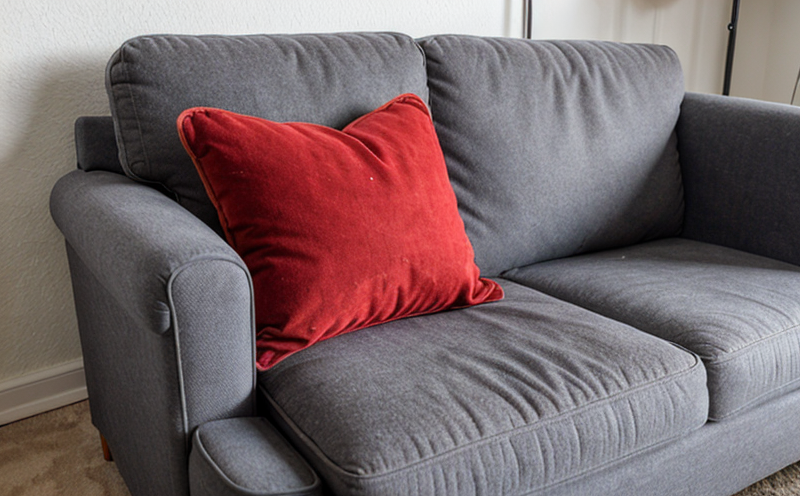ISO 2439 Indentation Hardness Testing of Foam Used in Cushions
The ISO 2439 standard is a critical tool used to measure the indentation hardness of foams, which plays a pivotal role in determining their durability and comfort. This test is particularly important for manufacturers of cushions and seating products, as it helps ensure that the materials meet quality and performance expectations.
Indentation hardness testing involves applying a specified load to a standard indenter (typically a flat-ended or spherical indenter) and measuring the resulting indentation depth in the foam material. The test is conducted under controlled conditions, ensuring that the results are repeatable and reliable. The primary purpose of this test is to quantify how much deformation occurs when a force is applied to the foam, which directly impacts its longevity and comfort.
For cushions used in furniture, understanding the indentation hardness is crucial because it influences several key aspects such as resilience, durability, and user comfort. Cushions with higher indentation hardness tend to maintain their shape better over time but may be less comfortable than those with lower hardness. Conversely, softer foams offer more cushioning but can lose their shape faster.
The test procedure is standardized in ISO 2439, which specifies the indenter type, load application rate, and indentation depth measurement. Compliance to this standard ensures that all materials are tested under consistent conditions, leading to accurate comparisons across different products or batches of foam.
Manufacturers often use this data for several purposes, including:
- Quality control: Ensuring consistency in product quality from batch to batch.
- Product development: Tailoring the hardness of foams to meet specific comfort and durability requirements.
- Purchasing decisions: Evaluating suppliers based on their ability to provide materials that meet indentation hardness specifications.
The test results are often used in conjunction with other mechanical tests, such as tear strength or compression modulus testing, to give a comprehensive view of the foam's properties. This holistic approach helps in selecting the most suitable material for specific applications, thereby optimizing both performance and cost.
| Standard | Description |
|---|---|
| ISO 2439:1997 | Method for the determination of indentation hardness of foams, based on static compression tests. |
| ASTM D3578-06(2018) | American Society for Testing and Materials standard for determining the indentation hardness of foams. |
The indentation hardness test is just one part of a broader suite of tests that manufacturers perform to ensure product quality. By adhering to international standards like ISO 2439, companies can demonstrate their commitment to producing high-quality products that meet global standards and customer expectations.
Applied Standards
| Standard | Description |
|---|---|
| ISO 2439:1997 | Method for the determination of indentation hardness of foams, based on static compression tests. |
| ASTM D3578-06(2018) | American Society for Testing and Materials standard for determining the indentation hardness of foams. |
The ISO 2439 standard is widely recognized and used globally, providing a consistent method for measuring indentation hardness. This ensures that manufacturers can compare results across different regions and suppliers confidently. Compliance with these standards not only enhances product quality but also fosters international trade by ensuring compatibility and interchangeability of products.
Quality and Reliability Assurance
The importance of quality assurance in the production of cushions cannot be overstated. ISO 2439 indentation hardness testing is a key component of this process, helping to ensure that each batch of foam meets the required specifications for comfort, durability, and performance.
Quality managers and compliance officers play a crucial role in overseeing these tests. They must ensure that all equipment used for the test is calibrated regularly and that operators are trained to perform the test accurately. This consistency is essential for obtaining reliable data that can be used to make informed decisions about product quality and process improvements.
R&D engineers also benefit from this testing, as it allows them to experiment with different foam formulations to achieve the desired hardness without compromising on comfort or durability. Procurement teams use these test results when selecting suppliers, ensuring that they source materials that meet the highest standards of quality.
By integrating ISO 2439 indentation hardness testing into their quality assurance protocols, companies can ensure that their cushions are not only durable but also provide optimal comfort to end-users. This commitment to quality and reliability is essential for maintaining a positive reputation in the market and building long-term customer trust.
International Acceptance and Recognition
The ISO 2439 indentation hardness test has gained widespread acceptance across industries, particularly within furniture manufacturing. Its international recognition stems from its standardization under ISO, a globally respected organization for setting technical standards.
Countries around the world have adopted this standard as part of their national regulations and industry practices. For instance, in Europe, EN 13864:2007 references ISO 2439 for determining indentation hardness, while in North America, ASTM D3578-06(2018) complements the international standard.
The universal applicability of this test is further underscored by its use in various applications beyond furniture cushions. Industries such as automotive seating, medical equipment, and even sports gear have adopted similar standards to ensure consistent material performance across different sectors.
Given its global acceptance, ISO 2439 indentation hardness testing has become a benchmark for quality assurance. Manufacturers who adhere to this standard can leverage their compliance with these international regulations to enter new markets more easily and build stronger relationships with customers worldwide.





